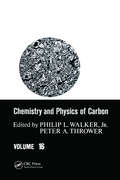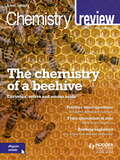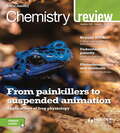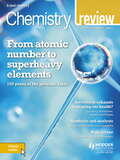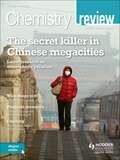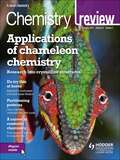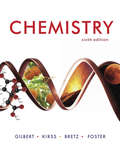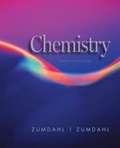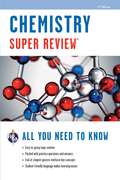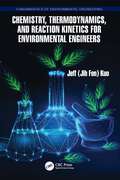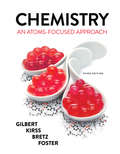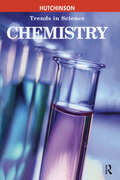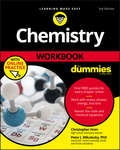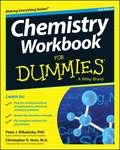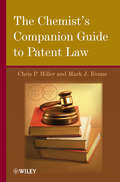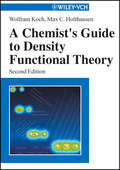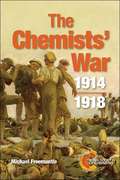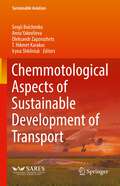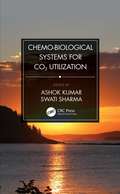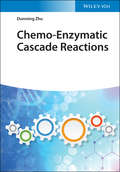- Table View
- List View
Chemistry & Physics of Carbon: Volume 16
by Philip L. WalkerThis book provides insights into the mechanisms of primary carbonization, discusses changes in the thermal-mechanical properties of carbon/carbon composites due to stress effects. It describes factors that result in the acceleration of the graphitization process.
Chemistry, Precision and Design
by Gregory Parker Verne BiddleGive your students a college-prep science education with Chemistry: Precision and Design. The text teaches students the basic principles of chemistry in an understandable and interesting manner. Abundant photographs, illustrations, and diagrams make chemical principles and applications clear and understandable as students learn about matter, stoichiometry, gases, chemical thermodynamics, chemical kinetics, nuclear and organic chemistry, and more. <p><p>Teaching students to see science as a way to bring glory to God, this text treats environmental issues such as ozone depletion, global warming, and nuclear power from a conservative perspective. In-text learning aids are integrated throughout, including key concepts, chapter outlines, worked examples, exercises keyed to the examples, "Chemistry in Action" examples, and chapter summaries.
Chemistry Review Magazine Volume 28, 2018/19 Issue 1
by Philip Allan MagazinesThis A-level chemistry magazine provides up-to-date articles specially written for students to help them gain the highest grade. Articles feature real-world applications of chemistry and signpost how these link with the exam. Chemistry Review also contains specific features on practical skills and on approaching exam questions.ContentsBreath of life Animal chemistry: Bees, honey and venom Drugs and dyes Did you know? Photoswitching isomers In pictures: Elements of smartphones Answer back: Polymers and azo dyes Revision note: The continuum of bonding Worth reading: The Disappearing Spoon Focus on industry: Extracting oil and gas Wonders of chemistry: Solar power: nature does it better Back page: Conservation and cyclododecane
Chemistry Review Magazine Volume 28, 2018/19 Issue 2
by Philip Allan MagazinesContentsHow clean is our air?Revision note: Disentangling polarityAnimal chemistry: Frogs and toadsIn pictures: Flying over firesWhat's your poison?Chemistry in medicine: Photochemistry and drug synthesisFocus on industry: What happens in an oil refinery?How science works: Investigating the structure of nucleic acidsSpectroscopy of space
Chemistry Review Magazine Volume 28, 2018/19 Issue 3
by Philip Allan MagazinesCONTENTSAre vehicle exhaust fumes damaging our health?Answer back: Synthesis and analysisAnimal chemistry: Cats and dogsIn pictures: Periodic table completed?Wonders of chemistry: Elements old and newWorth reading: Periodic Tales: the Curious Lives of the ElementsValuable vanillaMaking and doing: Systematic namesFocus on industry: Cracking and related refinery processesDid you know? Knock knock...Valentine chemistry
Chemistry Review Magazine Volume 28, 2018/19 issue 4
by Philip Allan MagazinesOrganic nitrogen: the secret killer in Chinese megacitiesFocus on industry: FrackingEncounter: Chemistry with altitudeWorth reading: The Private Life of AtomsIn pictures: What shape is my molecule?Phosphorus: the essential elementHow science works: The future of the periodic tableAnimal chemistry: SpidersLab page: Constructing an electrochemical cellIndex to Volume 28Back page: The chemistry of coral bleaching
Chemistry Review Magazine Volume 29, 2019/20 Issue 1
by Hodder Education MagazinesIs vaping really safer than smoking?How science works: EnergyA brief history of... Atomic structure: part 1Making and doing: Scrambled scientistsIn pictures: Cave chemistryCantharidin: from aphrodisiac to cancer cureAnswer back: Concentrate of sulfuric acidMaking and doing: Chemistry in knotsDid you know? Scrambled scientistsFocus on industry: AluminiumRadical clean-up
Chemistry Review Magazine Volume 29, 2019/20 Issue 2
by Hodder Education MagazinesPartitioning proteins: the blobs that won a Nobel prizeWonders of chemistry: Chameleon colour changesWhere would we be without chlorine?Encounter: The elephant in the labIn pictures: The elephant's toothpaste experimentLab page: Analysing limescale remover by acid-base titrationA brief history of... Atomic structure: part 2Focus on industry: IronCareers in chemistry: Cosmetic scientistBack page: Endangered elements
Chemistry (Sixth Edition): The Science In Context
by Thomas R. Gilbert Rein V. Kirss Natalie Foster Stacey Lowery BretzA research-based text that helps students visualize chemistry as they solve problems The exciting new Sixth Edition expands on the visualization pedagogy from coauthor Stacey Lowery Bretz and makes it even easier to implement in the classroom. Based on her chemistry education research on how students construct and interpret multiple representations, art in the book has been revised to be more pedagogically effective and to address student misconceptions. New projected visualization questions help instructors assess students’ conceptual understanding in lecture or during exams. This purchase offers access to the digital ebook only.
Chemistry, Study Guide
by Paul B. KelterReflects the unique problem-solving approach of the book. Includes alternate problem solving strategies, supplemental explanations, summaries of chapter sections, 400 worked examples, 800 self-practice tests, and answers to the exercises and self-tests--all designed to help students master the text material.
Chemistry Super Review - 2nd Ed. (Super Reviews Study Guides)
by Editors of REAREA's Chemistry Super ReviewGet all you need to know with Super Reviews!2nd EditionREA's Chemistry Super Review contains an in-depth review that explains everything high school and college students need to know about the subject. Written in an easy-to-read format, this study guide is an excellent refresher and helps students grasp the important elements quickly and effectively.Our Chemistry Super Review can be used as a companion to high school and college textbooks, or as a handy resource for anyone who wants to improve their chemistry skills and needs a fast review of the subject.Presented in a straightforward style, our review covers the material taught in a beginning-level chemistry course, including: atomic structure, bonding, chemical reactions, liquids, solids, gases, properties of solutions, chemical thermodynamics, and more. The book contains questions and answers to help reinforce what students learned from the review. Quizzes on each topic help students increase their knowledge and understanding and target areas where they need extra review and practice.
Chemistry, Thermodynamics, and Reaction Kinetics for Environmental Engineers (Fundamentals of Environmental Engineering)
by Jeff KuoThis book aims to be the preeminent university chemistry textbook for environmental engineers. It provides undergraduate and graduate environmental engineering students with basic concepts and practical knowledge about chemistry that they would need in their professional careers. It focuses on the fundamental concepts of chemistry and its practical applications (e.g., understanding fate and transport of chemicals/pollutants in the environmental as well as the chemical/physicochemical processes applied in environmental engineering industry). This book also serves as a valuable resource for entry-level professionals to solidify their fundamental knowledge in environmental engineering chemistry. This book Presents the fundamentals of chemistry with focus on the needs of environmental engineers. Explains how an understanding of chemistry allows readers a better understanding of the fate and transport of chemicals in the environment as well as various treatment processes. Examines the fundamentals of chemical reaction equilibrium from learning the basics of thermodynamics. Presents the basic types and designs of reactors as well as reaction kinetics.
Chemistry (Third Edition): An Atoms-focused Approach
by Thomas R. Gilbert Rein V. Kirss Stacey Lowery Bretz Natalie FosterA research-based, atoms-focused text that helps students visualize chemistry as they solve problems. The exciting new Third Edition expands on the visualization pedagogy from co-author Stacey Lowery Bretz and makes it even easier to implement in the classroom. Based on her Chemistry Education Research on how students construct and interpret multiple representations, art in the book has been revised to be more pedagogically effective and address student misconceptions. New projected visualization questions help instructors assess students’ conceptual understanding in lecture or during exams. This purchase offers access to the digital ebook only.
Chemistry Trends (Trends in Science)
by Keith B HuttonToday's fast-moving world of science will have far-reaching effects on all of our lives. Trends in Science is a series of of essential readings for anyone who wants to know more about how his or her future will be affected; as well, the series provides accessible and stimulating material for high school and college students, for researchers and librarians. All titles in the series provide: an introductory overview of the field in the last 100 years, reviewing the past but also predicting the new developments of the future; a detailed chronology of the most important milestones; an index of key terms and concepts; biographies of the most important scientists in each field and their role in shaping their particular branch of science; a listing of important Websites, a directory of organizations, and suggestions for further reading.
Chemistry Volume-1 class 12 - Tamil Nadu Board
by State Council of Educational Research and TrainingThe 12th Standard Chemistry Volume 1 textbook, published under the Tamil Nadu Free Textbook Programme, covers fundamental and advanced chemistry concepts essential for higher secondary students. It includes topics such as Metallurgy, p-Block Elements, Transition Elements, Coordination Chemistry, Solid State Chemistry, and Chemical Kinetics. The book emphasizes conceptual clarity with key features like example problems, self-evaluation exercises, and ICT-enabled learning resources. It provides insights into higher education and research opportunities in chemistry, along with information on entrance exams and scholarships. The book also highlights real-world applications of chemistry in metallurgy, material science, and industrial processes. Designed to develop analytical thinking and problem-solving skills, this comprehensive guide prepares students for academic and competitive exams.
Chemistry Workbook For Dummies
by Peter J. Mikulecky Chris HrenTake the confusion out of chemistry with hundreds of practice problems Chemistry Workbook For Dummies is your ultimate companion for introductory chemistry at the high school or college level. Packed with hundreds of practice problems, this workbook gives you the practice you need to internalize the essential concepts that form the foundations of chemistry. From matter and molecules to moles and measurements, these problems cover the full spectrum of topics you'll see in class—and each section includes key concept review and full explanations for every problem to quickly get you on the right track. This new third edition includes access to an online test bank, where you'll find bonus chapter quizzes to help you test your understanding and pinpoint areas in need of review. Whether you're preparing for an exam or seeking a start-to-finish study aid, this workbook is your ticket to acing basic chemistry. Chemistry problems can look intimidating; it's a whole new language, with different rules, new symbols, and complex concepts. The good news is that practice makes perfect, and this book provides plenty of it—with easy-to-understand coaching every step of the way. Delve deep into the parts of the periodic table Get comfortable with units, scientific notation, and chemical equations Work with states, phases, energy, and charges Master nomenclature, acids, bases, titrations, redox reactions, and more Understanding introductory chemistry is critical for your success in all science classes to follow; keeping up with the material now makes life much easier down the education road. Chemistry Workbook For Dummies gives you the practice you need to succeed!
Chemistry Workbook For Dummies
by Peter J. Mikulecky Chris HrenHundreds of practice problems to help you conquer chemistryAre you confounded by chemistry? Subject by subject, problem by problem, Chemistry Workbook For Dummies lends a helping hand so you can make sense of this often-intimidating subject. Packed with hundreds of practice problems that cover the gamut of everything you'll encounter in your introductory chemistry course, this hands-on guide will have you working your way through basic chemistry in no time.You can pick and choose the chapters and types of problems that challenge you the most, or you can work from cover to cover. With plenty of practice problems on everything from matter and molecules to moles and measurements, Chemistry Workbook For Dummies has everything you need to score higher in chemistry.Practice on hundreds of beginning-to-advanced chemistry problemsReview key chemistry conceptsGet complete answer explanations for all problemsFocus on the exact topics of a typical introductory chemistry courseIf you're a chemistry student who gets lost halfway through a problem or, worse yet, doesn't know where to begin, Chemistry Workbook For Dummies is packed with chemistry practice problems that will have you conquering chemistry in a flash!
The Chemist's Companion Guide to Patent Law
by Chris P. Miller Mark J. EvansWritten by an individual with experience as both a chemist and a patent attorney, The Chemist's Companion Guide to Patent Law covers everything the student or working chemist needs to know about patentability, explaining important concepts of patent law (such as novelty, non-obviousness, and freedom-to-operate) in easy-to-understand terms. Through abundant examples from case law as well as real-world situations with which a researcher might be faced, this book provides readers with a better understanding of how to put that knowledge into practice.
A Chemist's Guide to Density Functional Theory
by Wolfram Koch Max C. Holthausen"Chemists familiar with conventional quantum mechanics will applaud and benefit greatly from this particularly instructive, thorough and clearly written exposition of density functional theory: its basis, concepts, terms, implementation, and performance in diverse applications. Users of DFT for structure, energy, and molecular property computations, as well as reaction mechanism studies, are guided to the optimum choices of the most effective methods. Well done!" Paul von Rague Schleyer "A conspicuous hole in the computational chemist's library is nicely filled by this book, which provides a wide-ranging and pragmatic view of the subject.[...It] should justifiably become the favorite text on the subject for practioneers who aim to use DFT to solve chemical problems." J. F. Stanton, J. Am. Chem. Soc. "The authors' aim is to guide the chemist through basic theoretical and related technical aspects of DFT at an easy-to-understand theoretical level. They succeed admirably." P. C. H. Mitchell, Appl. Organomet. Chem. "The authors have done an excellent service to the chemical community. [...] A Chemist's Guide to Density Functional Theory is exactly what the title suggests. It should be an invaluable source of insight and knowledge for many chemists using DFT approaches to solve chemical problems." M. Kaupp, Angew. Chem.
The Chemists' War: 1914-1918
by Michael FreemantleWithin months of the start of the First World War, Germany began to run out of the raw materials it needed to make explosives. As Germany faced imminent defeat, chemists such as Fritz Haber and Carl Bosch came to the rescue with Nobel Prize winning discoveries that overcame the shortages and enabled the country to continue in the war. Similarly, Britain could not have sustained its war effort for four years had it not been for chemists like Chaim Weizmann who was later to become the first president of the State of Israel. Michael Freemantle tells the stories of these and many other chemists and explains how their work underpinned and shaped what became known as The Chemists' War. He reveals: * how chemistry contributed to the care of the sick and wounded and to the health and safety of troops; * how coal not only powered the war but was also an important source of the chemicals needed for the manufacture of explosives, dyes, medicines and antiseptics; * how Britain's production of propellants relied on the slaughter of tens of thousands of whales; * how a precious metal played a critical role in the war; * how poisonous chemicals were used as weapons of mass destruction for the first time in the history of warfare and how chemists developed gas masks for protection against these weapons; * how the British naval blockade of Germany imperilled agricultural production in the United States. The book will appeal to the general reader as well as the many scientists and historians interested in the Great War.
Chemmotological Aspects of Sustainable Development of Transport (Sustainable Aviation)
by Sergii Boichenko Anna Yakovlieva Oleksandr Zaporozhets T. Hikmet Karakoc Iryna ShkilniukThis book looks at chemmotological solutions to important questions surrounding sustainability and environmental safety of transport — both key priorities within the global strategy of sustainable development. Bringing together expanded versions of selected papers presented at the 8th International Scientific-Technical Conference: Problems of Chemmotology – Theory and Practice of Rational Use of Conventional and Alternative Fuels and Lubricants, contributors present solutions to problematic questions, including choosing feedstock and technologies of its processing for manufacturing alternative fuels, development and implementation of measures for improving environmental safety of transport, minimizing exhaust gases emission from transport, introducing new solution or improvements in systems of fuels supply and infrastructure, and changes in legislative and regulatory base for fuels and lubricants use. This collection will be an invaluable reference for researchers, professionals, and students involved in alternative aviation fuels, transport engineering, sustainable transport development, and fuels and lubricants.
Chemo-Biological Systems for CO2 Utilization
by Ashok Kumar Swati SharmaChemo-Biological Systems for CO2 Utilization describes the most recent advanced tools and techniques for carbon dioxide capture and its utilization. It discusses and compares the advantages of different systems and aids researchers and industrialists in understanding energy generation in the form of biofuels, bioelectricity, or biogas using chemicals; nanomaterials; and microbial, enzymatic, and chemo-enzymatic-integrated systems. It describes the importance and utilization of CO2 in living systems, and provides an overview of the various fundamental methods, policies, and techniques involved in CO2 conversion. Emphasis is placed on the production of value-added products using CO2, including biomethanol, industrial carbonates, and liquid or gaseous fuels. Features: Explains the correlations between microbial, biological, and chemical products and their roles in the conversion of CO2 into usable energy and related products. Being suitable for a broad audience, it addresses fundamental treatment methods for reusing environmental waste materials. Aids in decision-making and policy planning for environmental professionals. The information provided throughout this book will help researchers and professionals working in various industries to better understand the conversion of CO2 into energy-based products. Chemo-Biological Systems for CO2 Utilization also serves as a useful guide to seek alternative methods for clean energy and mitigating global climate change.
Chemo-Enzymatic Cascade Reactions
by Dunming ZhuA unique book that explores biocatalytic-chemical cascade reactions and their applications in the synthesis of valuable chemicals.
